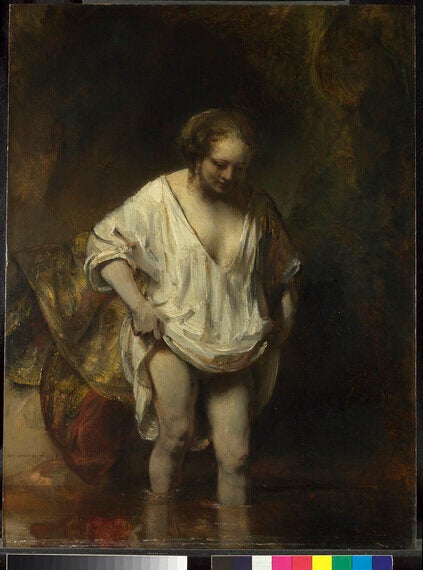
The new Rembrandt exhibition at the National Galley is not only an extraordinary collection of works from this great artist, but also incredibly moving. This show Rembrandt: The Late Works focuses on the painter's last years with works from the 1650s through to 1669, when Rembrandt died.
Interestingly, this exhibition has been hung by theme rather than in chronological order with works collated together under umbrella terms such as 'Contemplation' and 'Intimacy.' Explaining this approach, curator Betsy Wieseman says this is because Rembrandt revisited themes and ideas throughout his career and often worked on different styles and techniques simultaneously.
And this hanging works well in the labyrinth of small rooms in the subterranean galleries in the Sainsbury Wing. Each room is full with paintings, etchings and drawings on a single theme, infusing each section with strong emotion.
In the second room on 'Light and Experimental Technique' is the most impressive loan to the exhibition, The Conspiracy of the Batavians under Claudius Civilis. This painting has been loaned by The Royal Academy of Fine Arts in Sweden - only the third time the painting has been loaned away from the Academy since it took ownership in 1866. And it is such an important piece as it is a vivid example of Rembrandt's flawless manipulation of light.
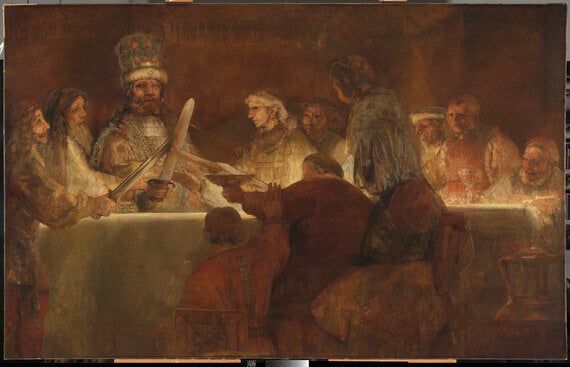
Figures are huddled around a table. Bright golden light is on that table, though its source is hidden from us. Yet the light bounces off the sharp metallic blades of the drawn swords highlighting the disfigured face of the one-eyed King.
Rembrandt's unflinching depiction of this darker side of human behaviour can be seen in a number of works on show.
In The Anatomy Lesson of Dr Joan Deyman, a shockingly white corpse lies with his body carved open, a deep cavity open in his chest. But though his body is flat, his neck has been snapped so that his head can be pushed vertical, allowing the Doctor to slice off the top of his skull revealing the damp pink brain.
You want to look away almost instantly, so vivid is the picture. What it must have been like, emotionally, for Rembrandt to work on such a harrowing set-up for so long, who knows, but he was committed to honest, unsentimental observation.
Similarly in his drawings of a woman hanging from a gibbet, the setting and context is removed - there are no gawping crowds or willing executioner - allowing Rembrandt to focus on how the body hung and to examine the features of the woman's face.
Yet in all of the works on show there seems to be a search for, and an investigation of, the full range of human emotions. Perhaps that was the impact of his advancing years and his personal contemplation of legacy and his place in the world, or it may be an outward projection of the difficulties he was experiencing in his personal life.
But these works are not indulgent. Instead the push to develop new technique is clear to see.
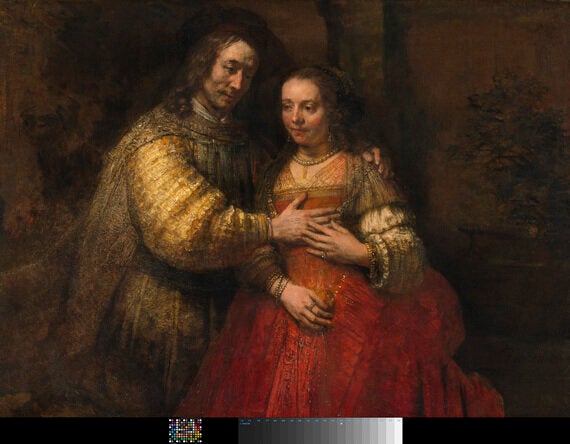
The Jewish Bride, about 1665, is one of Rembrandt's most celebrated works and is on show here after being lent by Rijksmuseum. This beautiful painting shows both these sides to Rembrandt - the head and the heart - perfectly.
The husband reaches out to his wife, touching her tenderly on her chest. Her hand reaches up to his though she doesn't look over to him. She doesn't have to as their intimacy and ease with each other's presence and company is complete.
The gold brocade on the husband's sleeve is bold and brilliant, swept on in thick daubs as Rembrandt used a palette knife to apply the paint. This was very much a new technique in Rembrandt's armoury and was not used widely to apply paint at this time, more to mix paints away from the canvas.
This technique Rembrandt uses again in a personal favourite of mine, The Suicide of Lucretia, 1666. This is a tragic picture of a young woman, eyes brimming with tears. Blood is seeping from her chest, staining her white shift and in her hands, the weapon that caused the wound - a sharp dagger. For Lucretia, about to die from her wound, has chosen to commit suicide then live and bear the shame of having been raped.
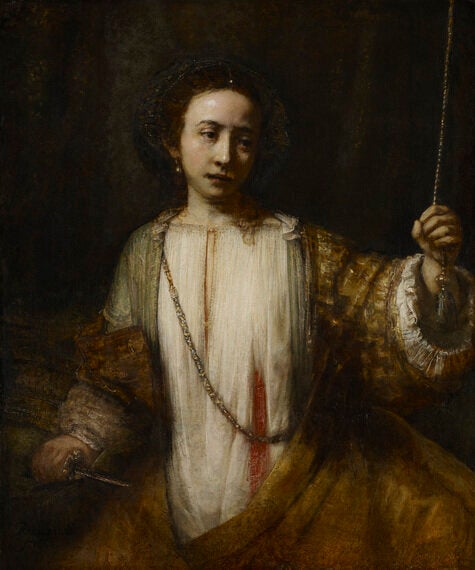
The gold brocade on her discarded robes has also been applied by the palette knife but, just as with The Jewish Bride, it is the emotion that grabs you - in this case tragedy rather than love.
This exploration of a conflicted mind was a recurring theme in Rembrandt's work in his later years. Another painting of Lucretia hangs in the exhibition. This time she's fully clothed, dagger in her hand, poised to kill herself but wrestling with the torrent of emotions in her head.
Similarly in the mournful The Apostle Bartholomew, 1657, Bartholomew grasps a knife, contemplating the meaning of life and death, and the gravity of his dedication to God for he would be martyred - the knife the mechanism of his death as Bartholomew would be skinned alive.
These heavy emotions may well reflect Rembrandt's personal circumstances as he did not have an easy time in these last years of his life.
Financially, he was teetering on the verge of bankruptcy. So worried was he about his creditors that he transferred the ownership of his house to his teenage son Titus, and then made Titus, who couldn't have been more than 13 or 14 years old, write out a will making his father the sole heir. That must have been tough for both father and son to deal with.
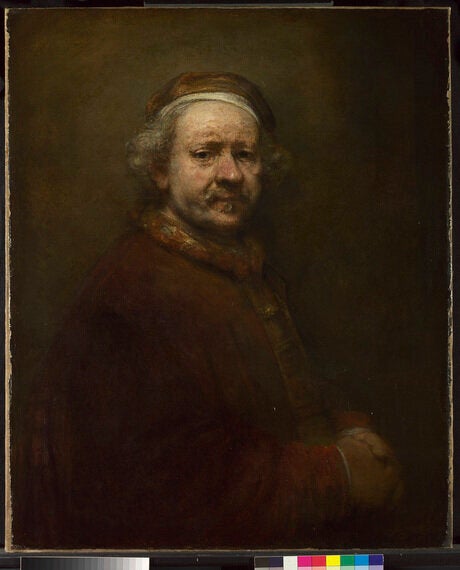
But tragically Rembrandt outlived both his son, who died in 1668, and his common-law wife, Hendrickje, who died in 1663. Indeed one of Rembrandt's self-portraits on show was painted in 1669, the year of his own death. It is a desperately moving representation of a man in terrible health and with the weight of the world on his shoulders. Though only 63, in the painting Rembrandt looks 20 years older.
And in his thin grey hair and troubled, furrowed brow Rembrandt, even at the end, is pushing not only technical boundaries (parts of the hair are defined through Rembrandt carving the end of his paintbrush into the oil on the canvas) but also ever-searching to convey the thoughts of a troubled mind.
National Gallery, London to January 18, 2015
Admission £16 (concessions available)
Image credits:
1.Rembrandt A Woman bathing in a Stream (Hendrickje Stoffels?), 1654 Oil on oak 61.8 x 47 cm © The National Gallery, London
2. Rembrandt Portrait of a Couple as Isaac and Rebecca, known as 'The Jewish Bride', about 1665 Oil on canvas 121.5 x 166.5 cm Rijksmuseum, on loan from the City of Amsterdam (A. van der Hoop Bequest)© Rijksmuseum, Amsterdam (SK-C-216)
3. Rembrandt The Conspiracy of the Batavians under Claudius Civilis about 1661-2, Oil on canvas 196 x 309 cm, The Royal Academy of Fine Arts, Sweden © Rijksmuseum, Amsterdam
4. Rembrandt The Suicide of Lucretia, 1666 Oil on canvas 109 x 93 cm Minneapolis Institute of Arts, The William Hood Dunwoody Fund 34.19 © The Minneapolis Institute of Arts, Minnesota
5. Rembrandt Self Portrait at the Age of 63, 1669 Oil on canvas 86 x 70.5 cm © The National Gallery, London